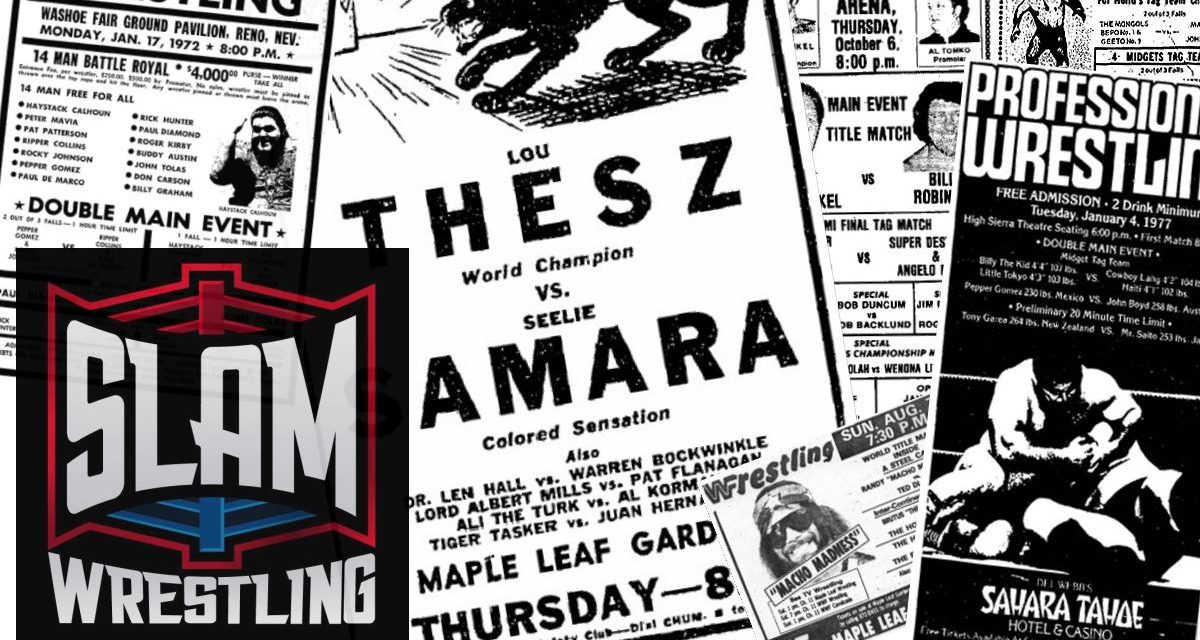When you entered Dick Steinborn’s townhouse in the Fan District of Richmond, Va., you truly experienced a blast from the past.
Amid the gym equipment he used as a personal trainer, Steinborn decorated the walls from floor to ceiling with wrestling artwork, much of which was attributable to his prowess as a photographer.
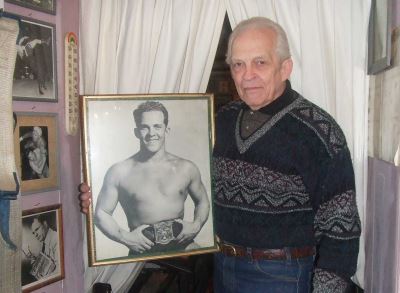
In 2007, Dick Steinborn poses with a photo of himself as a young champion. Photo by Shuhei Aoki
Buddy Rogers. Jim Barnett. Ray Stevens. Don Fargo. Lou Thesz. Ed “Strangler” Lewis. Promoters and champions from every era of post-World War I wrestling. Jack Dempsey. Toots Mondt, The last known photo of Steinborn’s wrestling “brother” Ray Gunkel before he died minutes after a match in 1972. Steinborn’s father Milo, a one-time strength performer whose wrestling career dated from the 1920s.
Steinborn died April 18, 2020, at 86 in Columbus, Ga., after being in declining health. He had been in Columbus since 2018 after living in Richmond and Orlando, Fla., where Milo promoted mat shows for many years.
“I got to see the world and I got to document it,” said Steinborn, who kept a darkroom in many of his residences to maintain the photographic record of his trusty Leica camera. “Milo gave me the opportunity and it was up to me to take advantage of it.”
As Randall Williams wrote in Through the Hoop in 1979, “Dick was the son who loved wrestling, loved the stink and sweat of dirty dressing rooms and, like his proud German father, loved the discipline of the gymnasium.”
Curly-haired and fair-skinned, Steinborn was a classic babyface, with the technical ability to match. The light-heavyweight was considered one of the best mat artists of his time. From the start of his career, he said he liked to stand in the back of the arena and watch matches from start to finish to get ideas for his own contests.
“He probably wasn’t, by any stretch, one of my best friends, but he and I had some of the most classic matches I ever had in the business,” Joe “The Assassin” Hamilton confided to Peach State Pandemonium. “We had a match in Augusta [Georgia] that went two hours and forty-five minutes with no falls in front of a sellout crowd. The crowd stood up yelling, ‘We want more!’ when it was done. They were thoroughly entertained. Augusta was always a tough crowd, but to entertain a crowd with a match like that was a hell of an accomplishment.” After the match, the rivals weighed themselves; Hamilton dropped 12 pounds and Steinborn lost seven.
Born Sept. 28, 1933, in St. Louis, Steinborn started wrestling in 1951, defeating Les Ruffin in Baltimore that July. After the match, Steinborn later recounted, several men toted a dead body into the locker room. The decedent was a fan who Steinborn said threw a shoe at him from ringside. In his recounting, Steinborn said one of the grizzled grapplers claimed, “You killed him,” causing him to leave the Baltimore Coliseum in tears to head back to his home in New York.
Despite the setback, Steinborn persisted in working on the East Coast, billed often as a 19-year-old instead of a 17-year-old to not run afoul of labor laws. He often appeared on the same cards as ex-boxer Primo Carnera, as his dad was one of the Ambling Alp’s handlers. After a brief swing with his dad in Europe, by mid-1952, the good-looking 18-year-old was a regular in Chicago and on national TV wrestling from the Windy City’s Rainbo Arena against the likes of Johnny Barend.
That gave him a chance to learn from the best like Jack O’Reilly (Harry Bartlett) and undercard guy in Georgia and elsewhere who built babyfaces’ careers. “He would have a way of turning the tables at the end of a match when he forced me into imitating the same cheating maneuver he had done earlier, and he’d have me get caught by turning the referee physically. I would get disqualified. He’d strut around that ring pointing to his head. I learned so much that way,” Steinborn said.
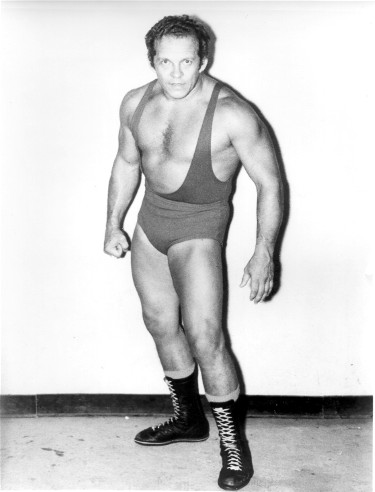
Dick Steinborn. Courtesy Chris Swisher
In 1953, when his father was promoting wrestling in Orlando, Steinborn moved his base to Florida, and though he’d wrestle in 14 different countries, he became best known for his successes in the Southeast. Billed as the youngest pro in the nation, Steinborn “has been trained in physical culture and wrestling almost since birth by his world renowned father,” the hometown Orlando Sentinel said. In Florida, he started regularly wrestling the outlandish Don Kalt (Don Fargo), who became a friend for half-a-century.
Steinborn’s father Milo was close to Virginia promoter Bill Lewis, who always guaranteed the younger Steinborn a prominent place on his cards; in fact, Milo refereed on some shows in which his son appeared.
“Lewis, who has a young son of his own, took quite a fancy to Dick Steinborn and has great respect for him as a wrestler,” the Petersburg Progress-Index reported in 1955.
How committed to the ring was Steinborn? It was where he got married and divorced. In January 1962, he married Janell Oates, Miss Columbus [Ga.] of 1961 and the sister of wrestlers Jerry and Ted Oates, the second of four wives (his first, Carol, died young of cancer), with “Moon River” playing through the loudspeakers.
“Wrestling is my profession and my life,” he said of the nuptials preceding a card in Columbus. “It means so much to me that the ring is where I decided I wanted to be married. Janell understands, so we both agreed the wedding would take place in the ring.”
The couple had four children, but a traveling wrestling schedule is not always conducive to a stable family existence. When the Steinborns prepared to divorce, Dick insisted on returning to the auditorium in Columbus, saying his father told him prospective divorcees in Germany returned to the church in which they were married, hoping that memories might rekindle the relationship.
“I told everyone, ‘I am not signing, I married Janell in a ring and if it’s going to be over, then it’ll be done in the same ring.’ I had high hopes that this would make a difference. It didn’t work,” he said.
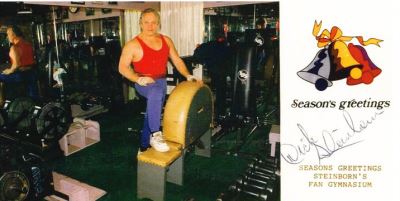
A Steinborn Christmas card.
It was not the only feminine thing that Steinborn encountered between the ropes; he beat Gorgeous George in 1960 in Atlanta when the Human Orchid was disqualified for spraying Steinborn with Chanel No. 10.
Because of his small frame — he strained to hit 215 pounds — Steinborn often did his best work as part of a tag team. He had great success in the Carolinas in 1956-57 as the young partner of George Becker after George’s brother Bobby died, holding the top tag title in that region.
“A successful team was one that had unusual double-teaming and fancy maneuvers that were different than any other team,” Steinborn explained in interviews for The Pro Wrestling Hall of Fame: The Tag Teams. “Usually about five or six of these double maneuvers were in successful tag team repertoires. Then, when they met a successful upcoming combination, usually babyfaces, the established teams would allow the babyfaces to upset maybe one, two or three maneuvers.”
That was exactly the formula Steinborn followed in his one of his most memorable teams — the pairing of Mr. High (Doug Gilbert) and Mr. Low (Steinborn). Steinborn entered Verne Gagne’s American Wrestling Association in 1962, only to see that Gilbert outclassed him in aerial wizardry with dropkicks and flying head scissors.
“I watched him and I said, ‘Holy cow, this guy is over — how am I going to get over?’ I can’t even do half the stuff he does. So I’ll wrestle. I’ll stay on the mat.” In their first match together, Steinborn sat on the bottom turnbuckle and Gilbert on the top. When they tagged and entered the ring, Gilbert vaulted over the top strand, and Steinborn climbed under the bottom one. The innovation was so clever that AWA owner Gagne left the TV control room to view the match from ringside; the duo quickly claimed the federation’s top tag title from Art and Stan Neilson.
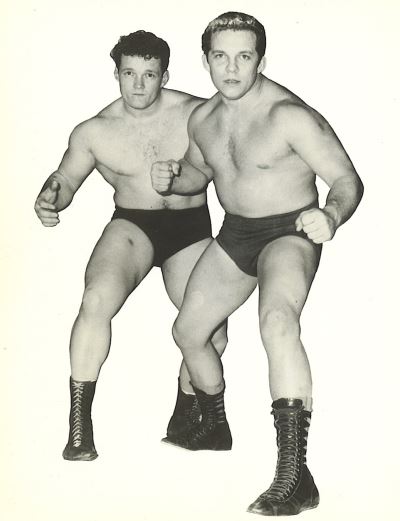
Doug Gilbert and Dick Steinborn. Courtesy Chris Swisher
In Georgia, Steinborn became close to Ray Gunkel, the top star and owner of the promotion, and worked as half-brother Dickie Gunkel. Steinborn worked on the undercard on the August 1972 show in Savannah, Ga., where Gunkel died after wrestling Ox Baker. Following Gunkel’s death, a wild scramble ensued for control of the lucrative Georgia territory, and Steinborn sided with Ray’s widow Ann in putting together the All-South Wrestling Alliance. That promotion lasted a couple of years, with Steinborn operating two towns, then he moved to the upstart International Wrestling Association in 1975.
Steinborn did not always have the best locker room reputation — Smith Hart once filed criminal charges against him in a box office dispute — and that might have kept him from holding more titles. As it was, his talent was undeniable. Among the more than two dozen titles Steinborn accumulated: World and U.S. Tag Team titles in Florida; Southern Tag Team title in Georgia; Georgia Tag Team title; North American Tag Team title in Texas.
After an estimated 6,000 matches, Steinborn retired in 1985 following a serious back injury. He didn’t exactly hang up his boots since he had boot laces tattooed on both legs. He became one of the great storytellers in the game, writing a column for Scott Teal’s Whatever Happened To … and interacting with fans on message boards, though, like the stories of many wrestlers, independent verification was sometimes wanting.
But entertaining? You bet. One story about veteran Mario Galento was among Steinborn’s gems. He met the long-haired, charismatic Galento in the Tennessee territory and stood stunned as he watched the wrestler hypnotize a young lady and bring her in and out of consciousness with the term “white cross.”
A few years later, Steinborn and Galento were working together in Georgia for promoter Leo Garibaldi, who didn’t buy into the hypnosis ideas. But Garibaldi was known as one of the best ide men in the sport, and he came up with a doozy. Galento was feuding with Paul “Butcher” Vachon because both men were using a hangman submission finisher; hoisting an opponent by the chin back to back. First, Garibaldi had Galento put a few fans under his spell. Then he hypnotized Steinborn and had him walk and act just like he did before sending him into the wrestle Vachon.
“Mario was sitting in my corner. I didn’t do any wrestling maneuvers at all. Leo had told me to stay on top of Butcher and beat the hell out of him. The match lasted no more than four minutes and I put Mario’s hold on the Butcher to win the ‘winner take all’ match. The Butcher was leaving the territory the next week. From then on Mario and I were tag partners in Georgia for a while. Strange but true,” Steinborn recalled.
Steinborn was a top star in Puerto Rico for the World Wrestling Council; he booked there and in Calgary briefly for Stu Hart. Wrestling in Hart’s territory as World Middle Heavyweight champion, he feuded with the young Dynamite Kid and eventually lost his belt to Bruce Hart.
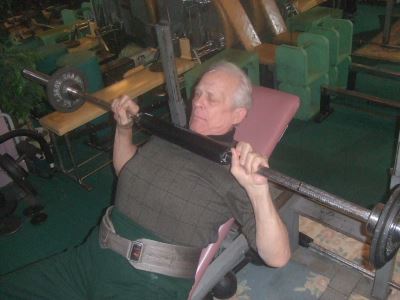
Steinborn works out in 2007. Photo by Shuhei Aoki
In retirement, Steinborn worked as a home-based physical trainer and had a bit part in The Murder of Mary Phagan, a 1988 television mini-series with Jack Lemmon and Richard Jordan filmed in Richmond and played chess with Jordan between scenes while he looked over the script.
“I’ve never worked a day in my life,” Steinborn said a few years ago. “The one thing I got out of wrestling is to be free. I can wake up in the morning and not have a clock to punch.”
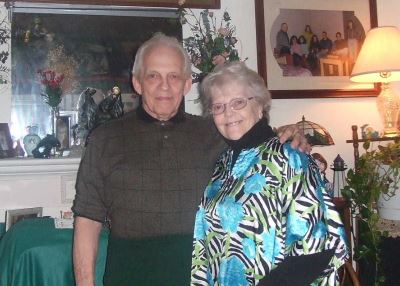
Dick with his fourth wife, Hazel, in 2007. Photo by Shuhei Aoki
He is survived by his children Candi Jones, Cooki Gilbert, Taffy Keller, Ginger Battle, Brooke Baker, Bradley Steinborn, and Jodi Williams; 14 grandchildren and 1 great-grandchild. A public service will not be held because of the COVID-19 pandemic.
— with files from Greg Oliver
Steven Johnson and Greg Oliver are co-authors of The Pro Wrestling Hall of Fame series of books and appreciate the many hours Dick Steinborn spent with them over the years.
RELATED LINK
